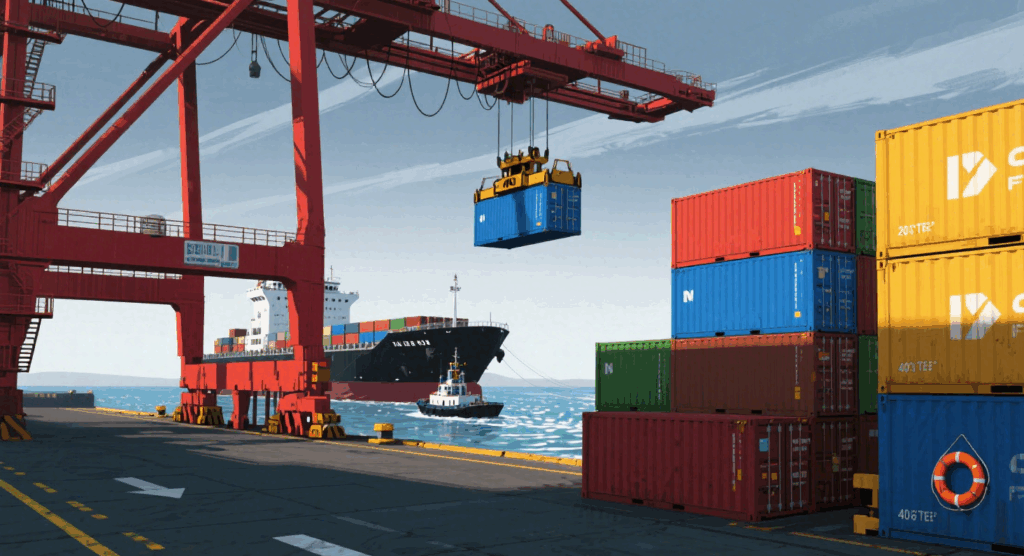1.What Is Berth Shipping?
Berth shipping refers to the process of docking a vessel at a designated space (berth) in a port where it can be safely loaded, unloaded, or serviced. It plays a vital role in maritime logistics and port operations, impacting cost, efficiency, and vessel turnaround time.
2.Types of Berths
Berths vary based on vessel type, cargo, and port infrastructure:
| Type of Berth | Used For | Key Features |
|---|---|---|
| Container Berth | Shipping containers | Gantry cranes, stacking yards |
| Bulk Cargo Berth | Grains, coal, ores | Conveyor belts, hoppers |
| Liquid Cargo Berth | Oil, gas, chemicals | Pipelines, loading arms, spill systems |
| Ro‑Ro Berth | Vehicles, trailers | Ramps, roll-on/roll-off platforms |
| Passenger Berth | Ferries, cruise ships | Gangways, customs facilities |
| Multi-purpose Berth | Mixed cargo types | Mobile cranes, forklifts |
3.How Berth Scheduling Works
Berth scheduling is critical to port efficiency. It includes:
- ETA Submission: Ship owners notify ports of arrival times.
- Berth Allocation: Ports assign berths based on availability, cargo type, and ship specs.
- Dynamic Adjustments: Weather, delays, or congestion may cause reassignments.
- Real-Time Monitoring: AIS and port systems track arrivals, dockings, and departures.
4.Berthing Charges & Costs
Berthing comes with several standard charges:
- Berth Occupancy Fee – Charged per hour or day based on vessel size.
- Wharfage – Cost for moving cargo across the quay.
- Mooring/Unmooring Fees – Charged for line handling and securing the vessel.
- Pilotage & Tug Charges – Required for large vessels or congested ports.
- Port Dues – General infrastructure usage fee.
Cost structures may vary by port and contract terms.

5.Berth Shipping vs Incoterms (CPT & CIF)
| Factor | CPT / CIF | Berth Shipping |
|---|---|---|
| Mode of Transport | CPT: Any, CIF: Sea only | Sea (at the port interface) |
| Risk Transfer | At carrier handoff / port of loading | At mooring / start of cargo ops |
| Cost Responsibility | Buyer vs Seller (based on Incoterm) | Port vs Carrier / Shipper (via berth contracts) |
| Insurance | Required for CIF | Optional, based on berth and port agreements |
6.Real-World Example: A Bulk Ship Delay
A vessel carrying grain to Rotterdam misses its allocated berth due to fog. As a result:
- Demurrage fees are charged for delays beyond allowed time.
- Downstream rail and trucking schedules collapse.
- The buyer faces production delays waiting for raw materials.
Efficient berth scheduling could have mitigated this domino effect.
7.Best Practices for Berth Shipping
- Use berth planning software to optimize schedules.
- Set clear communication protocols between ship, agent, and port.
- Pre-arrange berthing windows during peak seasons.
- Understand local berth restrictions (tide, draft, cargo limits).
- Conduct post-berthing reviews to improve future planning.
8.Summary: Why Berth Shipping Matters
Berth shipping is much more than a docking process. It affects port throughput, cargo timelines, vessel schedules, and overall logistics performance. Whether you’re a shipper, freight forwarder, or port operator, understanding berth shipping gives you a competitive edge in global trade.
Request a Quote
Need a tailored solution for your shipping from China?
Let TJ China Freight Forwarder assist you with reliable, cost-effective service.
FAQ:
Q1. What is a berth in shipping?
A berth is a designated dock space where ships moor for loading, unloading, or servicing.
Q2.How are berthing charges calculated?
Charges are based on vessel size, duration, and the type of berth or cargo handled.
Q3.Is berth shipping included in freight rates?
Sometimes. It depends on the shipping contract. Charges may be separate or included under port fees.
Q4.What is the berth allocation problem?
It refers to the logistical challenge of assigning berths to multiple arriving vessels in the most efficient way possible.
Q5.How can berth efficiency be improved?
Through digital berth planning, accurate ETAs, coordinated port communications, and infrastructure upgrades.
